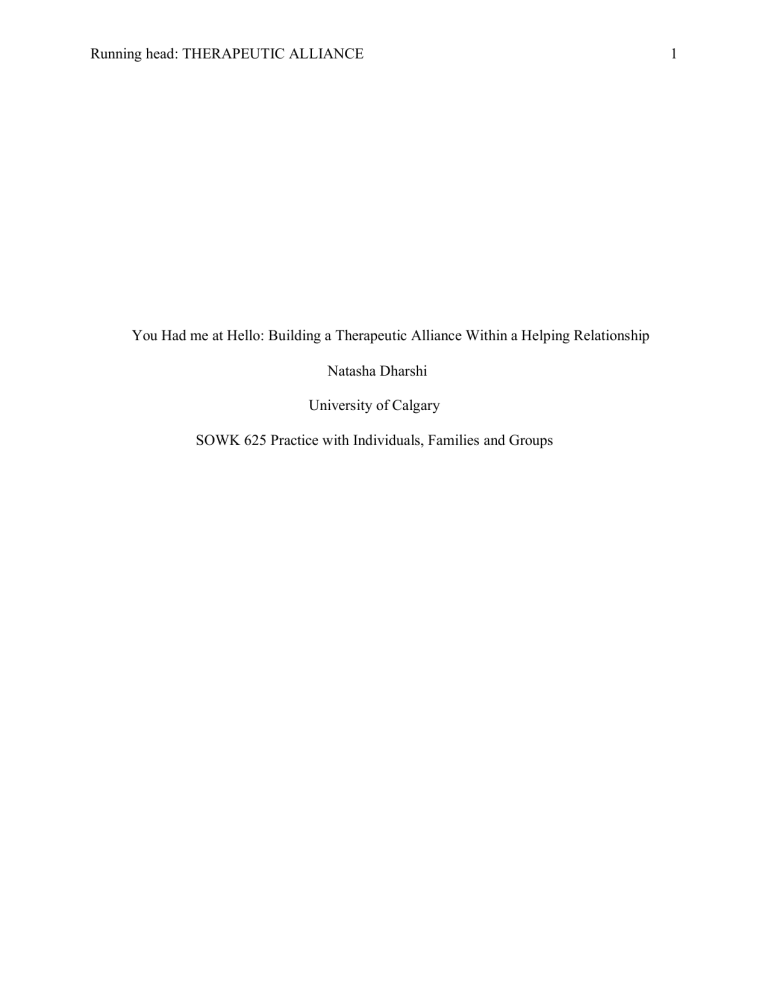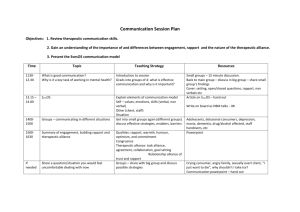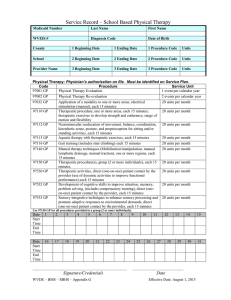
Running head: THERAPEUTIC ALLIANCE You Had me at Hello: Building a Therapeutic Alliance Within a Helping Relationship Natasha Dharshi University of Calgary SOWK 625 Practice with Individuals, Families and Groups 1 THERAPEUTIC ALLIANCE 2 ‘“She pulled me out of the gutter, if it wasn’t for her I would probably be in the hospital, but she pulled me out and I’m so glad she came into my life,” said Billie Graham’ (Franks, 2017). Billie is one of many success stories I have seen within my practice and has been a client that has made an imprint on my career. He has defied adversity and increased his resilience by capitalizing on his abilities and developing prosocial interactions in his life. In the beginning of our therapeutic relationship, Billie was very resistant on working with me. He had been in and out of many interactions with the system and had become jaded with the whole process. Despite his quality of life deteriorating as he sat isolated in his unit, he believed that working with me was going to be exactly what he had experienced before. His hope had dimmed and his drive to fight the systemic oppression he had been facing was lost. This is when it dawned on me that despite being in the helping profession not everyone is going to want to work with you and the therapeutic relationship itself will never be seamless. No matter what demographic you may be working with there will always be barriers, setbacks, miscommunication, lies, differing opinions and preconceived notions and beliefs. The beauty of a therapeutic alliance is building a foundation from the essence of just being human. Connecting from one being to the next and understanding that each individual trajectory is a story that must be carefully read is the beginnings of a helping relationship. In my previous experiences, the personal skills that have been beneficial to building helping relationships have been honesty and genuineness. Clients are very intuitive to both personal characteristics and rapport is often steadily built when they truly believe that you care and will be truthful with them about their situation and available options. Professionally, I have found that when you are detail oriented, thorough in your research and documentation, practice active listening and have been open to exploring different methods and suggestions it helps the THERAPEUTIC ALLIANCE 3 client to feel confident in your skill set and believe in the consistency and stability you will provide them. Some factors that I have found to interfere or challenge the development of a therapeutic alliance has been the transience of a population. When working in the homelessness sector I found that clients were often battling scarcity in obtaining resources. Not being able to meet their needs and provide for themselves deterred from any rapport or relationship building. The relationships built were scarce and intermittent, with clients only engaging when a basic need was to be met and they had no other options during desperate measures. Not having food, shelter, clothing, water or substances to function would significantly impact the development of any relationship leading to very shallow engagements. Some of the challenges involved in developing as well as maintaining a helping relationship is a lack of trust. For most vulnerable populations, they have consistently engaged in some realm of the system and have encountered poor experiences or results. They have succumbed to their oppression in society and no longer want to engage in any ‘help’ they can access. Not having lived experience to all the concerns or issues your clients may face can be a struggle as many individuals feel that if you haven’t experienced it yourself it is too difficult to understand. I found this particularly relevant in mandated populations. Establishing a therapeutic alliance is an imperative part of building rapport within a client relationship, although it is important to be mindful of our reactionary responses as practitioners when working with hard to serve populations. Caplan and Thomas (2002) discuss the idea of a ‘forgotten moment’ when working in a group setting with difficult clients and expressing a reactionary response to something that has been said within the session. This concept is about an awareness of your defensive reactions to moments of emotional conflict and using emotionally mindful techniques during anxiety THERAPEUTIC ALLIANCE 4 provoking events. Rather than bypassing these moments by ‘forgetting’ them, it is important to practice therapeutic resiliency by developing confidence in your ability to sit in the emotions long enough to process what is happening. Resisting reactionary responses by reflecting on the implications of your actions, promotes vulnerability in the client and the practitioner. Processing these moments reinforces the appropriate boundaries of responsibility in the client doing the work. The underlying premise is exhibiting attitudinal resilience that can be between the supervisor, the practitioner, the seasoned and new group members. The ability to maintain centered in this therapeutic alliance reinforces more appropriate behavioral responses resulting in empathic and supportive dialogue when gathering information (Caplan & Thomas, 2002). Working with difficult clients in an individualized or group setting can be stressful for the practitioner to maintain a therapeutic alliance and often leads to burnout. After continuously dealing with acerbic behaviors, combativeness or a client’s lack of willingness to work through their concerns we often feel frustrated or hopeless ourselves. Our jobs become less rewarding and can become a burden or emotionally taxing. Navigating through systemic barriers when developing this alliance can evoke reactionary responses of frustration and anxiety. It is important to allow ourselves the opportunity to recognize our emotions, hold them close, be aware of the outcomes they have on our thoughts, verbal and non-verbal cues and find a way to release them, either within a session or apart from it. When building such fragile relationships, it is important to be mindful of the resilience of both practitioner and client and the dynamics that may be beneficial or detrimental to both parties. THERAPEUTIC ALLIANCE 5 References Caplan, T., & Thomas, H. (2002). The forgotten moment: Therapeutic resiliency and its promotion in social work with groups. Social Work with Groups, 24(2), 5-26. doi: 10.1300/J009v24n02_02 Franks, C. (2017, October 16). Back on my feet. The Salvation Army Ottawa. Retrieved from http://salvationarmyottawa.ca/2017/10/back-on-my-feet/


